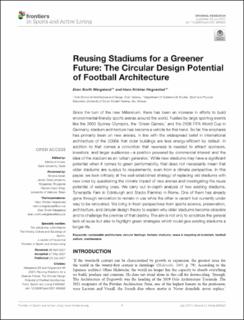| dc.description.abstract | Since the turn of the new Millennium, there has been an increase in efforts to build environmental-friendly sports arenas around the world. Fuelled by large sporting events like the 2000 Sydney Olympics, the ‘Green Games,’ and the 2006 FIFA World Cup in Germany, stadium architecture has become a vehicle for this trend. So far, the emphasis has primarily been on new arenas, in line with the widespread belief in international architecture of the 2000s that older buildings are less energy-efficient by default. In addition to that comes a conviction that newness is needed to attract sponsors, investors, and larger audiences—a position powered by commercial interest and the idea of the stadium as an ‘urban generator.’ While new stadiums may have a significant potential when it comes to green performability, that does not necessarily mean that older stadiums are surplus to requirements, even from a climate perspective. In this paper, we look critically at the well-established strategy of replacing old stadiums with new ones by questioning the climate impact of new arenas and investigating the reuse potential of existing ones. We carry out in-depth analysis of two existing stadiums, Tynecastle Park in Edinburgh and Stadio Flaminio in Rome. One of them has already gone through renovation to remain in use while the other is vacant but currently under way to be renovated. We bring in fresh perspectives from sports science, preservation, architecture, and circular design theory to explain why older stadiums become obsolete and to challenge the premise of that destiny. The aim is not only to scrutinize the general lack of reuse but also to highlight green strategies which could give existing stadiums a longer life. | |
